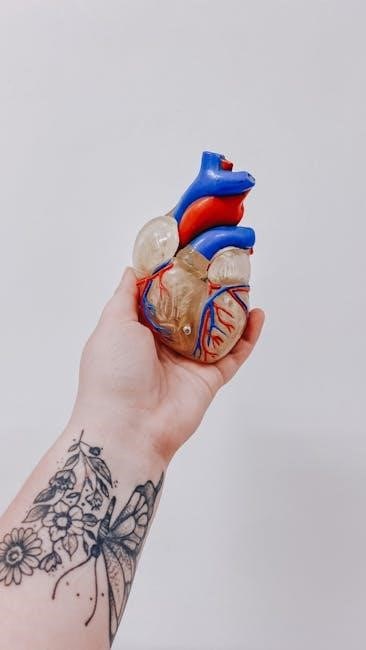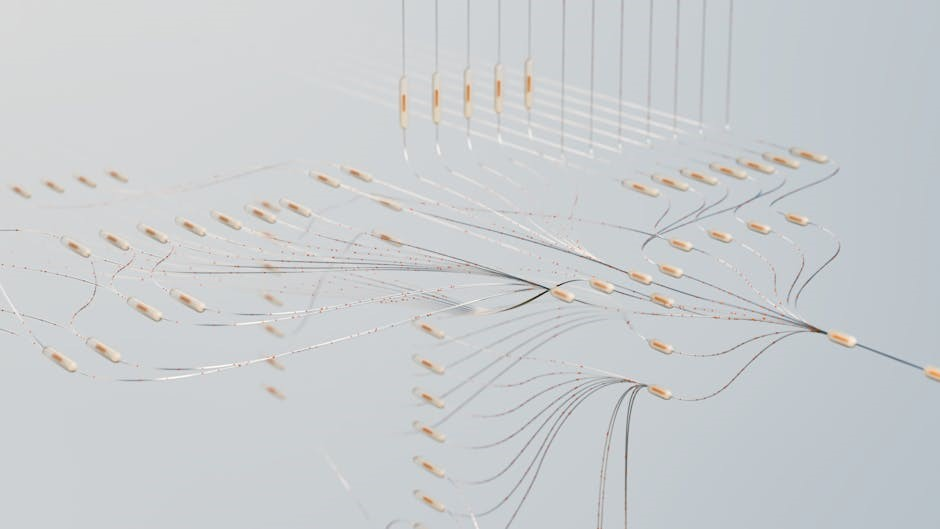The heart’s conduction system is a complex electrical network regulating cardiac rhythm and contractions․ It ensures synchronized beating, vital for maintaining proper blood circulation and overall cardiovascular health․
1․1 Overview of the Conduction System
The heart’s conduction system is a specialized network of electrical pathways that regulate cardiac rhythm and ensure synchronized muscle contractions․ It consists of highly specialized cells designed to generate and transmit electrical impulses․ Starting from the sinoatrial (SA) node, the system progresses through the atrioventricular (AV) node, the Bundle of His, and finally, the Purkinje fibers․ This sequential activation ensures that electrical signals are efficiently conducted from the atria to the ventricles, enabling coordinated heartbeats․ The conduction system operates autonomously but can be influenced by the autonomic nervous system to adjust heart rate in response to physiological demands․ Its proper functioning is critical for maintaining normal heart rhythms and overall cardiovascular health․
1․2 Importance in Cardiac Function
The conduction system plays a pivotal role in maintaining cardiac function by ensuring synchronized and efficient contractions of the heart muscle․ It coordinates electrical impulses, enabling the atria and ventricles to contract in a precise sequence․ This synchronization is essential for maintaining optimal blood circulation, as it ensures that blood is pumped effectively throughout the body․ The system’s ability to regulate heart rate and rhythm allows the heart to adapt to changing physiological demands, such as increased activity or stress․ Without a functioning conduction system, the heart’s ability to pump blood efficiently would be severely compromised, leading to potential complications like arrhythmias or even heart failure․ Thus, the conduction system is fundamental to maintaining cardiovascular health and overall bodily function․
1․3 Historical Discoveries
The conduction system of the heart has been studied for centuries, with key discoveries shaping our understanding․ In 1906, Keith and Flack identified the sinoatrial (SA) node as the heart’s natural pacemaker․ Later, Tawara’s 1906 discovery of the atrioventricular (AV) node and Bundle of His provided insights into impulse transmission․ The Purkinje fibers, identified earlier by Jan Evangelista Purkinje in 1839, were later linked to rapid ventricular contraction․ These findings built on earlier work by scientists like William Harvey, who described blood circulation in 1628, and Luigi Galvani, who explored electricity’s role in muscle contraction․ The development of electrocardiography (ECG) by Willem Einthoven in 1903 further revolutionized the study of cardiac electrical activity․ These historical milestones laid the foundation for modern cardiology and the treatment of rhythm disorders․
1․4 Key Terms and Definitions
Understanding the conduction system requires familiarity with specific terms․ The Sinoatrial (SA) Node is the heart’s natural pacemaker, initiating electrical impulses․ The Atrioventricular (AV) Node relays signals between atria and ventricles․ The Bundle of His and Purkinje Fibers conduct impulses to ventricular muscles․ Action Potential refers to the electrical charge changes triggering contractions․ Electrical Impulses are the signals coordinating heartbeat timing and rhythm․ These terms form the foundation for discussing the conduction system’s structure and function․
Structure of the Conduction System
The conduction system comprises the sinoatrial node, atrioventricular node, Bundle of His, and Purkinje fibers, working sequentially to regulate heartbeat timing and synchronization․
2․1 Main Components Overview
The conduction system of the heart is a specialized network of cells and fibers responsible for generating and transmitting electrical impulses․ It includes the sinoatrial (SA) node, the atrioventricular (AV) node, the Bundle of His, and the Purkinje fibers․ The SA node acts as the natural pacemaker, initiating electrical impulses that trigger atrial contractions․ The AV node delays these impulses, ensuring proper timing for ventricular filling․ The Bundle of His conducts impulses from the AV node to the ventricles, while the Purkinje fibers rapidly distribute them across the ventricular muscle, coordinating contractions․ This sequential activation ensures efficient blood pumping․ Each component plays a critical role in maintaining a synchronized and rhythmic heartbeat, essential for overall cardiovascular function and health․
2․2 Sinoatrial (SA) Node
The sinoatrial (SA) node, located in the right atrium near the superior vena cava, acts as the heart’s natural pacemaker․ It initiates electrical impulses that trigger cardiac contractions, setting the heart rate․ Composed of specialized pacemaker cells, the SA node generates rhythmic electrical activity without external stimulation․ Its intrinsic firing rate determines the resting heart rate, typically 60-100 beats per minute․ The SA node’s electrical activity is regulated by the autonomic nervous system, allowing the heart to adapt to physiological demands․ This small but critical structure ensures the heart beats in a coordinated and rhythmic manner, making it essential for maintaining normal cardiac function and overall health․
2․3 Atrioventricular (AV) Node
The atrioventricular (AV) node is a crucial part of the heart’s conduction system, acting as a relay station between the atria and ventricles․ Located near the septal leaflet of the tricuspid valve, it delays electrical signals to ensure proper timing for ventricular contraction․ This delay allows the atria to fully empty before the ventricles contract, optimizing cardiac efficiency․ The AV node also functions as an electrical filter, preventing rapid or irregular impulses from reaching the ventricles․ Its unique electrical properties, such as a longer refractory period, help regulate heart rhythm and prevent arrhythmias․ Dysfunction in the AV node can lead to conduction disorders, such as heart block or arrhythmias, highlighting its importance in maintaining normal cardiac function․
2․4 Bundle of His and Purkinje Fibers
The Bundle of His is a group of specialized cardiac cells that transmit electrical impulses from the AV node to the ventricles․ It divides into the left and right bundle branches, ensuring synchronized ventricular contractions․ The Purkinje fibers, originating from these branches, form an extensive network across the ventricular walls․ These fibers are large, fast-conducting cells that rapidly propagate electrical signals, enabling precise and coordinated muscle contractions․ Together, the Bundle of His and Purkinje fibers are critical for maintaining proper ventricular rhythm and ensuring efficient blood pumping․ Damage to these structures can lead to serious arrhythmias, highlighting their vital role in cardiac function․

Electrical Impulses and Heartbeats
The conduction system generates electrical impulses, initiating heartbeats․ These impulses travel through the heart, coordinating contractions for efficient blood circulation․ This synchronized process is vital for maintaining cardiac rhythm and overall health․
3․1 Generation of Electrical Impulses
The heart’s electrical impulses are generated by the sinoatrial (SA) node, often called the natural pacemaker․ Located in the right atrium, the SA node initiates rhythmic electrical discharges approximately 60-100 times per minute․ These impulses arise from spontaneous depolarization due to unique ion channel properties, particularly the hyperpolarization-activated cyclic nucleotide-gated (HCN) channels․ The SA node’s cells exhibit automaticity, meaning they can generate electrical activity without external stimulation․ The process begins with a slow influx of sodium and potassium ions, creating a resting membrane potential․ As the membrane depolarizes, voltage-gated calcium channels open, further driving the action potential․ This intrinsic rhythm ensures the heart beats consistently, adapting to physiological demands while maintaining coordination with the rest of the conduction system․
3․2 Transmission Through the Heart
The conduction system transmits electrical impulses seamlessly through the heart, ensuring coordinated contractions․ Starting from the SA node, impulses travel across the atria, triggering depolarization․ The AV node acts as a relay station, delaying signals to allow atrial contraction․ From there, impulses race through the Bundle of His and Purkinje fibers, spreading rapidly across the ventricles․ This synchronized transmission guarantees that electrical signals reach every cardiac muscle cell, enabling precise and efficient pumping․ The speed and direction of impulse propagation are carefully regulated to maintain proper heart rhythm and function․ This intricate process is essential for adapting heart rate to physiological needs, such as during exercise or rest․
3․3 Regulation of Heart Rate
The heart rate is primarily regulated by the autonomic nervous system, which includes the sympathetic and parasympathetic divisions․ The sympathetic nervous system increases heart rate during stress or physical activity, while the parasympathetic nervous system, via the vagus nerve, slows it down during rest․ Hormones like adrenaline also play a role in accelerating heart rate․ The SA node, as the natural pacemaker, sets the baseline heart rate, but its activity is modulated by these external factors․ Additionally, factors such as blood pressure, oxygen levels, and emotional state influence heart rate regulation․ This complex interplay ensures the heart adapts to varying physiological demands efficiently․ Understanding these mechanisms is crucial for diagnosing and managing heart rhythm disorders․ Proper regulation of heart rate is essential for maintaining optimal cardiac function and overall health․
3․4 Coordination of Contractions
The conduction system ensures synchronized heart contractions by coordinating electrical impulses․ The SA node initiates the heartbeat, triggering atrial contractions․ The AV node delays impulses, allowing atria to fully contract before ventricles․ The Bundle of His and Purkinje fibers rapidly transmit signals to ventricular muscles, ensuring simultaneous contraction․ This coordination is vital for efficient blood pumping․ Misynchronization can lead to arrhythmias, highlighting the system’s critical role in maintaining cardiac function and overall health․

Clinical Significance
The conduction system’s proper function is crucial for diagnosing arrhythmias, monitoring cardiac health, and guiding therapies․ Its dysfunction often leads to severe heart conditions requiring medical intervention․
4․1 Role in Diagnosis
The conduction system plays a vital role in diagnosing cardiac arrhythmias and other heart conditions․ Abnormalities in electrical impulses can be detected through electrocardiograms (ECGs) and Holter monitors, which measure heart rhythm patterns․ These tools help identify irregularities such as atrial fibrillation, ventricular tachycardia, or heart blocks․ Additionally, imaging techniques like echocardiograms and cardiac MRIs can reveal structural issues affecting the conduction pathways․ Understanding the conduction system enables healthcare providers to pinpoint defects, such as AV blocks or bundle branch blocks, which are critical for accurate diagnoses․ Invasive electrophysiological studies further allow precise mapping of electrical activity, aiding in complex cases․ This diagnostic insight is essential for guiding appropriate treatments, including medications, pacemakers, or catheter ablations, ensuring effective management of cardiac disorders․
4․2 Monitoring Techniques
Monitoring the heart’s conduction system is crucial for diagnosing and managing cardiac rhythm disorders․ Common techniques include electrocardiography (ECG), which records electrical activity, and Holter monitoring for 24-hour tracking․
Implantable loop recorders are used for intermittent arrhythmias, while stress tests assess heart activity during exercise․ Tilt-table tests help diagnose fainting spells related to conduction issues․
Advanced imaging like cardiac MRI provides structural insights, and electrophysiological studies (EPS) are used in complex cases․ These tools help identify abnormalities, guide treatment, and assess risk․
Regular monitoring ensures timely interventions, improving patient outcomes and quality of life․ Each method offers unique benefits, enabling personalized care for diverse cardiac conditions․
4․3 Therapeutic Implications
The conduction system’s dysfunction often necessitates targeted therapies․ Pacemakers and implantable cardioverter-defibrillators (ICDs) are commonly used to correct arrhythmias and restore normal heart rhythm․ Radiofrequency ablation is employed to destroy malfunctioning electrical pathways, while medications like beta-blockers and antiarrhythmics regulate heart rate․ Emerging therapies, such as cardiac resynchronization therapy (CRT), improve coordination in failing hearts․ Advances in genetics and stem cell research offer promising avenues for repairing or replacing damaged conduction tissues․ Personalized treatment plans, based on the underlying cause of dysfunction, are critical for optimizing outcomes․ These therapies not only alleviate symptoms but also enhance quality of life and reduce mortality rates in patients with conduction system disorders․
4․4 Case Studies and Examples
A 45-year-old patient experienced syncope due to intermittent third-degree AV block, highlighting the conduction system’s critical role․ Diagnosis via ECG showed complete electrical dissociation between atria and ventricles․ Pacemaker implantation restored normal rhythm․
A 70-year-old with symptomatic sick sinus syndrome underwent genetic testing, revealing SCN5A mutations affecting the SA node․ An artificial pacemaker successfully managed symptoms․
A young athlete with Wolff-Parkinson-White syndrome experienced supraventricular tachycardia․ Catheter ablation of the accessory pathway resolved symptoms, enabling return to sports․
These cases underscore the conduction system’s importance and the impact of disorders, demonstrating the need for precise diagnostics and personalized treatments․

Disorders of the Conduction System
Disorders of the conduction system disrupt electrical signals, causing arrhythmias or heart block․ Conditions include Wolff-Parkinson-White syndrome, bundle branch block, and AV nodal dysfunction, often requiring medical intervention․
5․1 Types of Disorders
Disorders of the conduction system vary widely, including arrhythmias such as atrial fibrillation and ventricular tachycardia, heart block (first-, second-, or third-degree), and bundle branch blocks․ Other conditions include Wolff-Parkinson-White syndrome, characterized by an accessory electrical pathway, and sick sinus syndrome, where the SA node fails to function properly․ Additionally, AV nodal reentrant tachycardia and Purkinje fiber dysfunction can disrupt normal electrical conduction․ These disorders often result from congenital abnormalities, aging, or acquired conditions like coronary artery disease or electrolyte imbalances․ Accurate diagnosis and treatment are critical to restore normal heart rhythm and prevent complications․
5․2 Symptoms and Detection
Symptoms of conduction system disorders vary but often include dizziness, fainting, palpitations, shortness of breath, and chest pain․ These occur due to irregular or ineffective heartbeats․
- Symptoms: Patients may experience fatigue, lightheadedness, or syncope (fainting), especially during physical activity or stress․
- Detection Methods: Diagnosis relies on electrocardiograms (ECG), Holter monitors, and stress tests to assess electrical activity and rhythm disturbances․
- Additional Tests: Event recorders and echocardiograms may be used to identify intermittent issues or underlying structural heart disease․
- Blood Tests: These help rule out conditions like electrolyte imbalances or thyroid disorders that can mimic conduction system abnormalities․
Early detection is crucial for managing conditions effectively and preventing complications like heart failure or arrhythmias․
5․3 Diagnostic Methods
Diagnosing conduction system disorders involves various methods to assess electrical activity and structural integrity․ An electrocardiogram (ECG) is the primary tool, detecting arrhythmias and conduction delays․ Holter monitoring provides continuous 24-hour ECG recordings, capturing intermittent issues․ Event monitors are used for sporadic symptoms, while echocardiography evaluates structural heart abnormalities․ Cardiac catheterization can assess electrical pathways in detail․ Tilt table testing is employed for suspected vasovagal syncope․ In complex cases, electrophysiological studies (EPS) map the heart’s electrical system․ Blood tests may rule out underlying conditions․ These methods help pinpoint abnormalities, guiding appropriate treatment strategies for conduction-related disorders, ensuring accurate and effective patient care․
5․4 Treatment Options
Treatment for conduction system disorders depends on the severity and type of condition․ Medications, such as anti-arrhythmics, may stabilize heart rhythms․ Pacemakers are often used to regulate heartbeats in cases of bradyarrhythmias․ Implantable cardioverter-defibrillators (ICDs) are employed for life-threatening arrhythmias․ Catheter ablation can correct faulty electrical pathways․ In severe cases, surgical interventions, such as bypass grafting or valve repair, may be necessary․ Lifestyle modifications, including stress reduction and dietary changes, can complement medical treatments․ Emerging therapies, like gene therapy and stem cell treatments, are being explored for future applications․ Each treatment is tailored to the patient’s specific condition and medical history, ensuring optimal outcomes and improved quality of life․

Modern Research and Developments
Modern research focuses on genetic factors, advanced imaging, and stem cell therapies to enhance understanding and treatment of the heart’s conduction system․
6․1 Advances in Understanding
Recent advancements in molecular biology and imaging techniques have significantly enhanced our understanding of the heart’s conduction system․ Researchers have identified specific genetic markers linked to congenital arrhythmias, enabling earlier diagnosis and personalized treatments․ Additionally, high-resolution imaging modalities now provide detailed insights into the structure and function of the conduction pathways, aiding in the development of more precise therapeutic interventions․ Studies on ion channel physiology have also uncovered mechanisms underlying abnormal heart rhythms, paving the way for novel drug therapies․ These discoveries collectively improve diagnostic accuracy and treatment outcomes for patients with conduction system disorders․
6․2 Emerging Technologies
Emerging technologies are revolutionizing the study and treatment of the heart’s conduction system․ Advanced mapping technologies, such as high-resolution 3D mapping, enable precise visualization of electrical pathways․ Wearable devices like smartwatches now monitor cardiac rhythms in real-time, detecting irregularities early․ Innovations in bioengineering, such as bioartificial tissues, offer potential for repairing damaged conduction pathways․ Artificial intelligence (AI) and machine learning algorithms improve the analysis of ECG data for better diagnosis․ Additionally, gene therapy and stem cell research aim to restore normal electrical function․ Catheter ablation techniques, guided by advanced imaging, treat arrhythmias more effectively․ Finally, optogenetics explores controlling heartbeats with light, offering futuristic therapeutic possibilities․ These technologies collectively enhance understanding, diagnosis, and treatment of the conduction system, paving the way for personalized medicine and improved patient outcomes․
6․3 Future Research Directions
Future research on the heart’s conduction system will focus on advancing personalized medicine, exploring regenerative therapies, and improving diagnostic tools․ Scientists aim to develop better strategies for repairing or replacing damaged conduction tissues, potentially using stem cells or bioengineered materials․ Additionally, the integration of artificial intelligence and machine learning could enhance the analysis of cardiac electrical activity, leading to earlier detection of disorders․ Another key area is understanding genetic factors influencing the conduction system, which may pave the way for tailored treatments․ Collaborative efforts between cardiologists, engineers, and geneticists will be crucial for driving innovation․ Furthermore, research into wearable devices and real-time monitoring systems could revolutionize how conduction system disorders are managed․ These advancements promise to improve patient outcomes and quality of life significantly․
6․4 Collaborative Efforts
Collaborative efforts in studying the heart’s conduction system involve multidisciplinary teams of cardiologists, researchers, and engineers․ These partnerships aim to advance understanding and develop innovative treatments․ Governments, universities, and private companies often fund joint projects to explore new therapies and technologies․ International collaborations, such as the Cardiovascular Research Consortium, pool resources and expertise to tackle complex cardiac conditions․ Sharing data and findings accelerates progress in fields like arrhythmia management and pacemaker technology․ Public-private partnerships also drive clinical trials and device development․ Such teamwork fosters a holistic approach to addressing cardiac disorders, ensuring breakthroughs benefit global healthcare systems․ By uniting diverse perspectives, collaborative efforts pave the way for groundbreaking discoveries and improved patient outcomes in cardiac care․
The heart’s conduction system is crucial for maintaining synchronized electrical impulses, ensuring proper cardiac function and overall cardiovascular health․
7․1 Summary of Key Points
The conduction system of the heart is a specialized network of cells and fibers that generate and transmit electrical impulses, ensuring coordinated cardiac contractions․ It includes the sinoatrial node, atrioventricular node, Bundle of His, and Purkinje fibers, each playing a distinct role in maintaining heart rhythm․ The system is vital for regulating heart rate and synchronizing atrial and ventricular contractions․ Disorders in this system can lead to arrhythmias, highlighting its clinical significance․ Modern research continues to uncover new insights, improving diagnostic and therapeutic approaches․ Understanding the conduction system is essential for advancing cardiovascular medicine and enhancing patient outcomes․
7․2 Final Thoughts
7․3 References and Further Reading
For a deeper understanding of the conduction system of the heart, several resources are recommended:
- Guyton and Hall’s Textbook of Medical Physiology provides detailed insights into cardiac electrophysiology․
- Hurst’s The Heart offers comprehensive coverage of cardiac anatomy and function․
- The American Heart Association (AHA) publishes guidelines on cardiac conduction disorders and treatments․
- Circulation and Heart Rhythm journals feature cutting-edge research on cardiac electrical activity․
- Braunwald’s Heart Disease includes clinical perspectives on conduction system disorders․
Online resources like the National Institutes of Health (NIH) and Mayo Clinic also provide accessible information for both professionals and students․
Comments